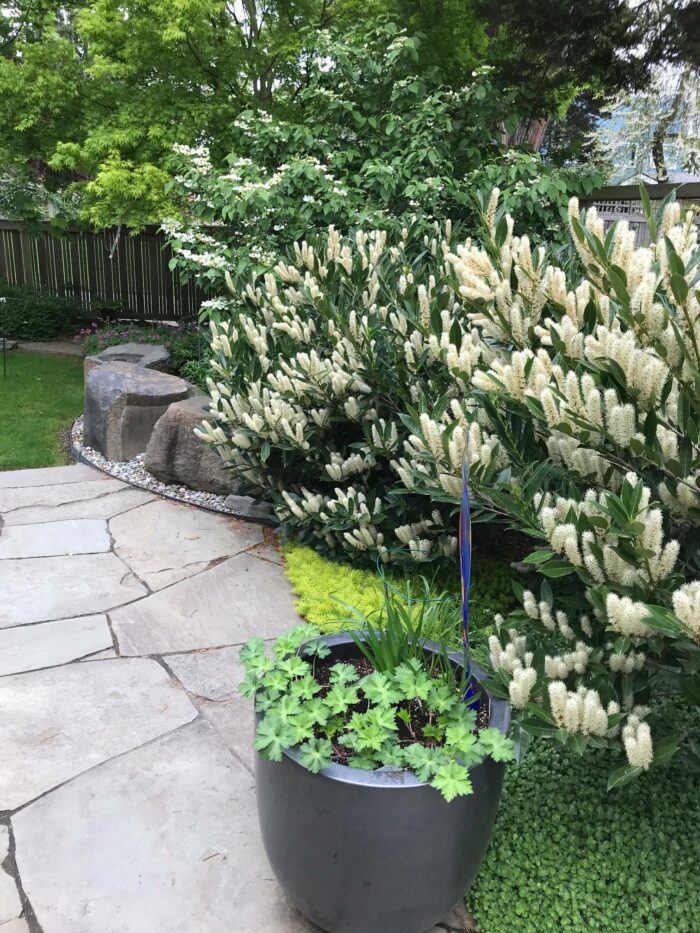
My name is Angela O’Brien-Ruff, and I live in Seattle, Zone 8b. I have contributed to GPOD a couple of times over the last few years. (Check out her previous articles here, one and two.) We have thawed out from a nearly 8-inch snowfall that came at the end of December, and as I survey some of the damage around my garden I wonder how and if some of the plants will emerge in the spring. Below are a few photos of our garden from last year. I have attempted to include botanical names where possible.
 I confess to having many failures on this sliver of space on the north side of our house. However, this new combination of plantings seems to be happy here. The pavers are Montana argillite and stones salvaged from my neighbor’s yard renovation. Top of the photo to bottom: Japanese forest grass (Hakonechloa macra, Zones 5–9), sword fern (Polystichum munitum, Zones 6–9), Polygonatum odoratum ‘Byakko’ (Solomon’s seal, Zones 3–8), Wallich’s wood fern (Dryopteris wallichiana, Zones 6–9), deer fern (Blechnum spicant, Zones 5–8), Brunnera ‘Jack Frost’ (Zones 3–8), spleen wort (Asplenium trichomanes, Zones 3–9), Japanese anemone (Anemone hupehensis, Zones 4–8), baby tears ground cover (Soleirolia soleirolii, Zones 8–11), hardy fuchsia (Fuchsia hybrid, Zones 7–11), and Hydrangea (Zones 5–9).
I confess to having many failures on this sliver of space on the north side of our house. However, this new combination of plantings seems to be happy here. The pavers are Montana argillite and stones salvaged from my neighbor’s yard renovation. Top of the photo to bottom: Japanese forest grass (Hakonechloa macra, Zones 5–9), sword fern (Polystichum munitum, Zones 6–9), Polygonatum odoratum ‘Byakko’ (Solomon’s seal, Zones 3–8), Wallich’s wood fern (Dryopteris wallichiana, Zones 6–9), deer fern (Blechnum spicant, Zones 5–8), Brunnera ‘Jack Frost’ (Zones 3–8), spleen wort (Asplenium trichomanes, Zones 3–9), Japanese anemone (Anemone hupehensis, Zones 4–8), baby tears ground cover (Soleirolia soleirolii, Zones 8–11), hardy fuchsia (Fuchsia hybrid, Zones 7–11), and Hydrangea (Zones 5–9).
 Podophyllum ‘Spotty Dotty’ (Zone 6–9), Lenten rose ‘Cotton Candy’ (Helleborus × hybridus ‘Cotton Candy’, Zones 4–8), Epimedium versicolor ‘Sulphureum’ (Zones 5–9), Japanese forest grasses Hakonechloa macra and H. macra ‘Aureola’ (Zones 5–9). This area is a work in progress.
Podophyllum ‘Spotty Dotty’ (Zone 6–9), Lenten rose ‘Cotton Candy’ (Helleborus × hybridus ‘Cotton Candy’, Zones 4–8), Epimedium versicolor ‘Sulphureum’ (Zones 5–9), Japanese forest grasses Hakonechloa macra and H. macra ‘Aureola’ (Zones 5–9). This area is a work in progress.
 Hardy ground orchid Bletilla ‘Yokohama’ (Zones 6–9) in the shade garden next to Japanese forest grass (Hakonechloa macra ‘Aureola’)
Hardy ground orchid Bletilla ‘Yokohama’ (Zones 6–9) in the shade garden next to Japanese forest grass (Hakonechloa macra ‘Aureola’)
 Mature Otto Luyken laurel shrubs (Prunus laurocerasus ‘Otto Luyken’, Zones 6–9) in bloom in the spring with Viburnum plicatum tomentosum ‘Mariesii’ (Zones 5–8) and sitting stones beyond, Sedum ‘Angelina’ (Zones 5–8) and Sedum ternatum (Zones 3–9) below. The Otto Luyken were originally small, one-gallon plants that have outgrown their stated mature height, but they are a welcome sight in the winter with their dark, evergreen leaves. The pot contains Agapanthus ‘Storm Cloud’ (Zones 7–10) and hardy Geranium ‘Rozanne’ (Zones 5–8) that will eventually cascade over the pot.
Mature Otto Luyken laurel shrubs (Prunus laurocerasus ‘Otto Luyken’, Zones 6–9) in bloom in the spring with Viburnum plicatum tomentosum ‘Mariesii’ (Zones 5–8) and sitting stones beyond, Sedum ‘Angelina’ (Zones 5–8) and Sedum ternatum (Zones 3–9) below. The Otto Luyken were originally small, one-gallon plants that have outgrown their stated mature height, but they are a welcome sight in the winter with their dark, evergreen leaves. The pot contains Agapanthus ‘Storm Cloud’ (Zones 7–10) and hardy Geranium ‘Rozanne’ (Zones 5–8) that will eventually cascade over the pot.
 A fellow gardening friend gave me these sweet pea (Lathyrus odoratus, annual) seeds she saved from her garden. I love the fragrance and color but did not know the name. Thanks to an article in the February 2022 issue of Fine Gardening magazine, I’m pretty sure these are ‘Indigo King’.
A fellow gardening friend gave me these sweet pea (Lathyrus odoratus, annual) seeds she saved from her garden. I love the fragrance and color but did not know the name. Thanks to an article in the February 2022 issue of Fine Gardening magazine, I’m pretty sure these are ‘Indigo King’.
 Nothing can lift my spirits on a cold February day more than a bouquet of hellebore blossoms floating in a bowl. The black ones are Helleborus Winter Jewels, ‘Slate Double’. The pure white one tinged in raspberry is Helleborus ‘Spring Bright’. I can’t identify the green and purple ones.
Nothing can lift my spirits on a cold February day more than a bouquet of hellebore blossoms floating in a bowl. The black ones are Helleborus Winter Jewels, ‘Slate Double’. The pure white one tinged in raspberry is Helleborus ‘Spring Bright’. I can’t identify the green and purple ones.
 Camellia sasanqua ‘Apple Blossom’ (Zones 7–9) with beautiful pearlescent blossoms in November. It can be a nice evergreen bush or espaliered against a fence.
Camellia sasanqua ‘Apple Blossom’ (Zones 7–9) with beautiful pearlescent blossoms in November. It can be a nice evergreen bush or espaliered against a fence.
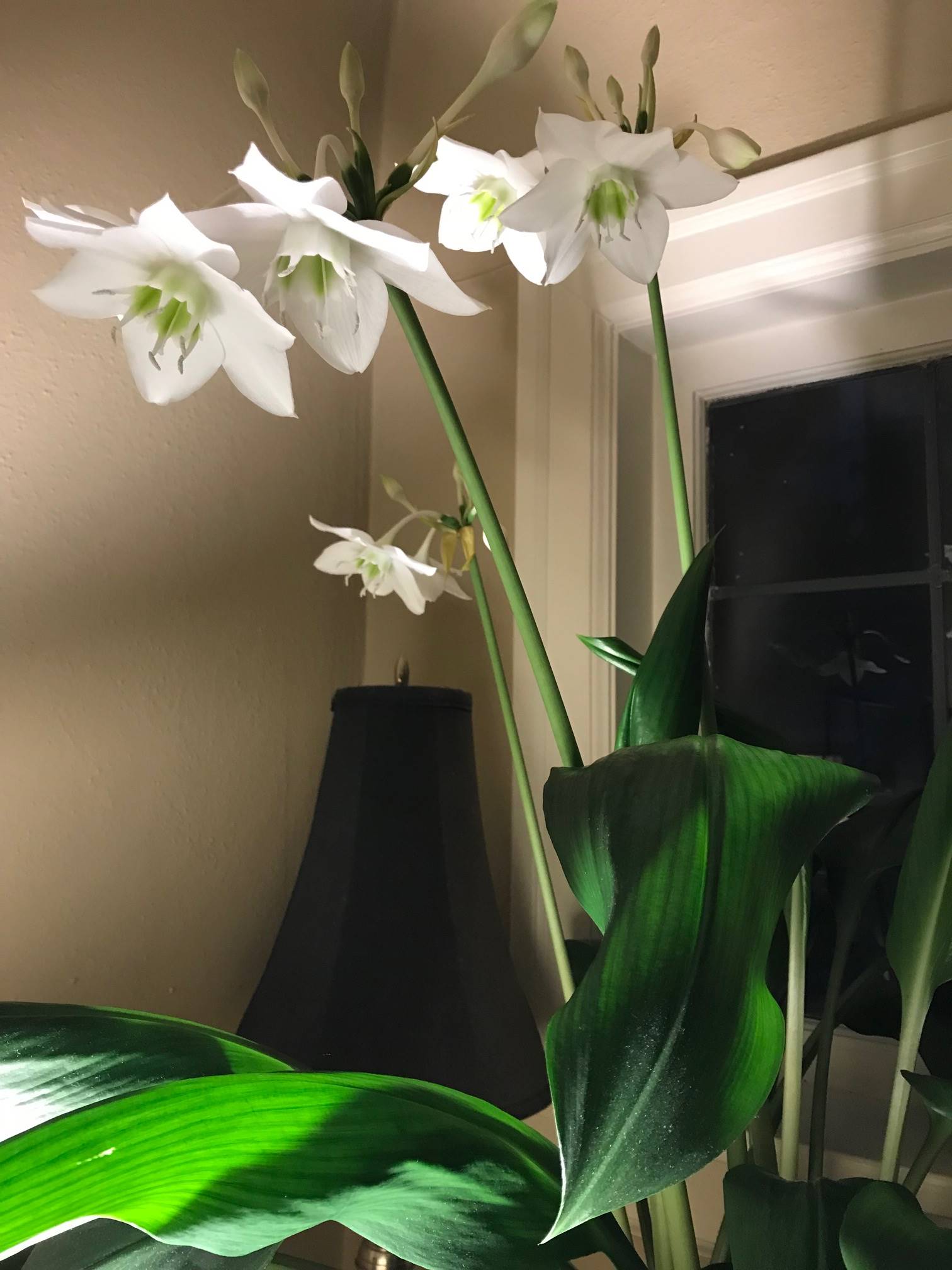 Amazon lily (Eucharis amazonica) is a tropical bulb that normally grows outdoors in Zone 10 or higher, but I love it as a houseplant.
Amazon lily (Eucharis amazonica) is a tropical bulb that normally grows outdoors in Zone 10 or higher, but I love it as a houseplant.
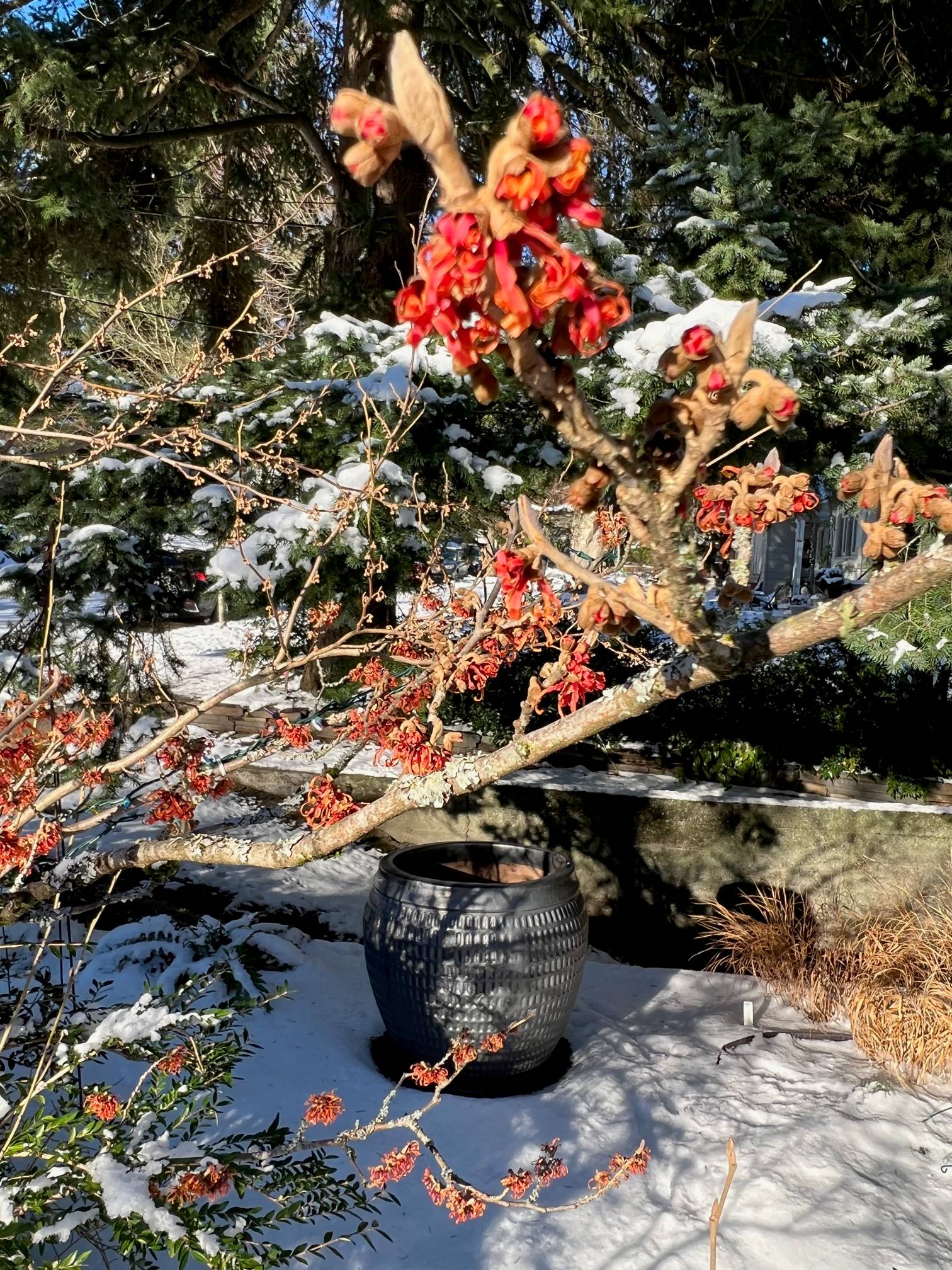 Witch hazel ‘Jelena’ (Hamamelis ‘Jelena’, Zones 4–9) blooming during our recent snow. Most witch hazels are grown for their fragrance, but I was drawn to this one’s burnt orange blossoms that appear in winter.
Witch hazel ‘Jelena’ (Hamamelis ‘Jelena’, Zones 4–9) blooming during our recent snow. Most witch hazels are grown for their fragrance, but I was drawn to this one’s burnt orange blossoms that appear in winter.
 I discovered this ginkgo tree (Ginkgo biloba, Zones 3–8) in a traffic circle on a walk in the neighborhood near my house. The contrast of the lemon-yellow leaves against the bright blue sky was stunning.
I discovered this ginkgo tree (Ginkgo biloba, Zones 3–8) in a traffic circle on a walk in the neighborhood near my house. The contrast of the lemon-yellow leaves against the bright blue sky was stunning.

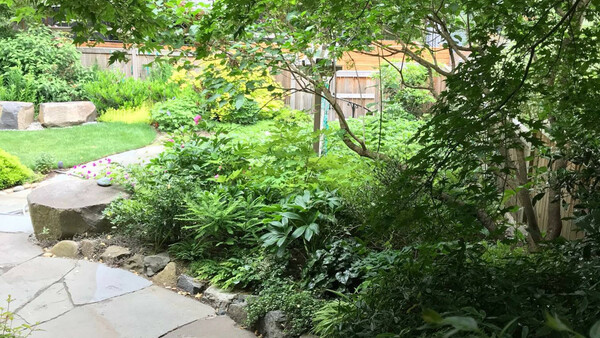

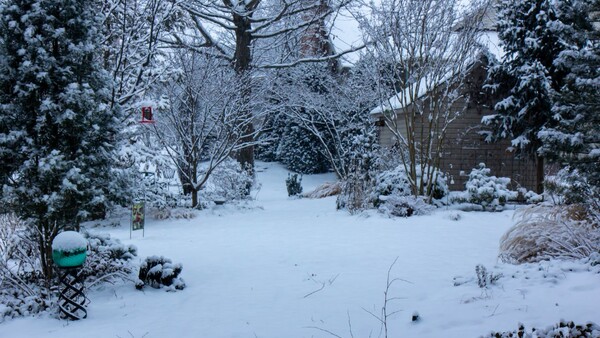













Comments
Just wonderful. I thought the Amazon lily was an orchid. Absolutely gorgeous. The sweet peas made me smile. There is light at the end of this winter’s tunnel. One certainly would not see any hellebore blooms in February here in Canada. One of m favourites as well. A fine showing.
Love that mayapple!
Your garden is fabulous!
I saved 3 of your photos to inspire me to try to grow Sweet Peas, the Mayapples with the spots, and I already have a Hardy Fuchsia, but loved your photo...I looked at your old posts too.
You really have created a beautiful garden...I like your style.
I, too, looked at your old posts. All of your photos are wonderful! I felt as though I could almost smell the fragrances and touch those flowers in your beautiful gardens. I particularly like your stone path. Beautifully done.
I so envy you being able to grow camellias, and that one is just beautiful! We're just one zone too cold here. I did have one for quite a few years in the greenhouse, but it's not the same as seeing one like yours! Also, the clethra (I think?) in the first photo . . . ours look like something that one would eat!
I love your garden. I live in Newcastle, WA. I just planted a Spotty Dotty in my backyard last spring. I'm hoping that it will eventually look nice as yours and develop into a nice clump.
Beautiful - especially loved that flame colored witch hazel.
You have many beautiful plants and I have a question. I live near Salem, Oregon, also an 8B zone, and I have several Sasanqua Camellias that have been in the ground several years and they never bloom. I would like to know your secret to all those blooms. I had one plant that was still in the pot and it bloomed profusely, so am I not watering enough? Do the Sasanquas require a lot of water or fertilizer? I would greatly appreciate your input. Erla
I’ve observed that my sasanquas that get some morning sun have more blooms than those located in the shade.
So beautiful!!!
Lovely photos, thanks for sharing!
I love the laurel blossoms and the general uplift of the plant. I am not familiar with this particular laurel. Would love to have one.
Log in or create an account to post a comment.
Sign up Log in